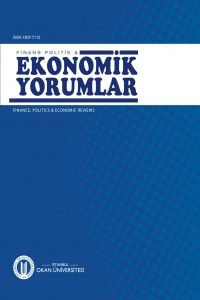Para Politikasının Etkilerinde Sektörel Asimetriler: Türkiye İçin VAR Analizi
Literatürde para politikasının makro değişkenler üzerine etkisini vektör otoregresif modelleri ile inceleyen çok sayıda çalışma yer almaktadır. Ancak, son zamanlardaki bazı çalışmalar para politikasının sektörel etkileri üzerinde durmaya başlamıştır. Parasal aktarım mekanizmasının anlaşılmasında sektörel analiz, makro değişkenlerle yapılan analizden daha yararlıdır, çünkü bu yöntem sayesinde para politikasının sektörel etkileri daha kolay anlaşılmaktadır. Diğer bir ifadeyle bu analiz para politikasının sektörler üzerine asimetrik etkisinin olup olmadığını ortaya koyabilmektedir. Bu yüzden, bu tür analizler parasal aktarım mekanizması hakkında daha fazla bilgi sağlamaktadırlar. Bu çalışmada, Türkiye’de çeşitli sektörlerin para politikasına tepkileri analiz edilmiştir. Tahmin sonuçlarına göre, Türkiye’de çeşitli sektörler para politikasındaki değişikliklere çok farklı tepkiler vermiştir. Bu asimetri sektörel yapılardaki veya endüstrilerin karakteristik özelliklerindeki farklılıklardan kaynaklanan faiz oranına karşı farklı duyarlılıklar ile açıklanabilir.
Anahtar Kelimeler:
Sektörel Analiz, Para Politikası, Asimetrik Etki, VAR, EtkiTepki
Sectoral Asymmetries in the Effects of Monetary Policy: VAR Analysis for Turkey
There are a lot of papers investigating the effect of monetary policy on aggregate variables within the vector autoregressive framework. Recently, some of these studies have focused on sectoral effects of monetary policy. Sectoral analysis is more helpful than aggregate analysis in the understanding of the monetary transmission mechanism because it is easy to understand sectoral effects of monetary policy. In other words, it can be revealed whether or not there is any asymmetric effect of monetary policy. So, it provides advantageous information about monetary transmission mechanism. In this study, we have investigated the response of various industrial sectors to monetary policy in Turkey. According to the estimation results, there are significant differences between industries in response to monetary policy in Turkey. This asymmetry is explained by different sensitivity to interest rate originated from different sectoral structure or characteristics of these industries.
Keywords:
Sectoral Analysis, Monetary Policy, Asymmetric Effect, VAR, Impulse-Response,
___
- ARNOLD, Ivo J.M.; (2001), “The Regional Effects of Monetary Policy in Europe”, Journal of Economic Integration, 16(3), pp. 399-420.
- ARNOLD, Ivo J.M. and Evert B. Vrught; (2002), “Regional Effects of Monetary Policy in the Netherlands”, International Journal of Business and Economics, 1(2), pp. 123-134.
- BERNANKE, Ben S. ve Alan S. BLINDER; (1992), “The Federal Funds Rate and the Channels of Monetary Policy”, American Economic Review, 82 (4), ss. 901-921.
- CARLINO, Gerald and Robert DEFINA; (1998), “The Differential Regional Effects of Monetary Policy”, The Review of Economics and Statistics, 80(4), pp. 572- 587.
- CENGİZ, Vedat ve Mehmet DUMAN; (2008), “Türkiye’de Banka Kredi Kanalının Önemi Üzerine Etki Tepki Fonksiyonlarına Dayalı Bir Değerlendirme(1990-2006)”, H.Ü. İktisadi ve İdari Bilimler Fakültesi Dergisi, 26 (2), ss. 81-104.
- DALE, Spencer and Andrew G. HALDANE; (1995), “Interest Rates ant the Channels of Monetary Transmission: Some Sectoral Estimates”, European Economic Review, 39(9), pp.1611- 1626.
- DEDOLA, Luca and Francesco LIPPI; (2005), “The Monetary Transmission Mechanism: Evidence from the Industries of five OECD Countries”, European Economic Review, 49(6), 2005, pp. 1543-1569.
- DICKEY, David. A., and, Wayne A. FULLER; (1979), Distribution of the Estimators for Autoregressive Time Series with a Unit Root, Journal of The American Statistical Association, 74(366a), 427-431.
- ENDERS, Walter; (2004), Applied Econometric Time Series, 3rd Edition, John Wiley & Sons.
- GANLEY, Joe and Chris SALMON; (1997), “The Industrial Impact of Monetary Policy Shocks: Some Stylised Facts”, Bank of England Working Paper, Paper No: 68, pp. 26-28, http://www.
- bankofengland.co.uk/archive/Documents/historicpubs/workingpapers/1997/wp68.pdf, 24.04.2016 GERTLER, Mark and Simon GILCHRIST; (1994), “Monetary Policy Business Cycles and the Behavior of Small Manufacturing Firms”, Quarterly Journal of Economics, 109(2), pp. 309- 340.
- GRANGER, C. William and Paul NEWBOLD; (1974), “Spurious Regressions in Econometrics”, Journal of Econometrics, 2(2), 111-120.
- GÜLOĞLU, Bülent ve Orhan SEVİNÇ; (2008), “Türkiye’de Parasal Aktarım Mekanizmalarının Makroekonomik Etkileri”, İktisat İşletme ve Finans, 23(268), ss. 94-118.
- GÜNDÜZ, Lokman (2001). “Türkiye’de Parasal Aktarım Mekanizması ve Banka Kredi Kanalı”, İMKB Dergisi, 5(18), ss.13-30
- ISSN: 1307-7112
- Başlangıç: 1963
- Yayıncı: İstanbul Okan Üniversitesi
Sayıdaki Diğer Makaleler
Türkiye’de Büyükşehir Belediyelerinin Bütçe Sürdürülebilirliği Üzerine Bir Uygulama
Mehmet DAĞ, Oktay KIZILKAYA, Fatma KIZILKAYA
Amasya Üniversitesinin İl Ekonomisine Etkisi
Rüştü YAYAR, Hilal ŞEKER, Nagehan KARANFİL
Finansal İstikrarı Sağlamaya Yönelik Alternatif Politika Çerçeveleri
Mustafa Kemal YILMAZ, Orkun İÇTEN
Para Politikasının Etkilerinde Sektörel Asimetriler: Türkiye İçin VAR Analizi
